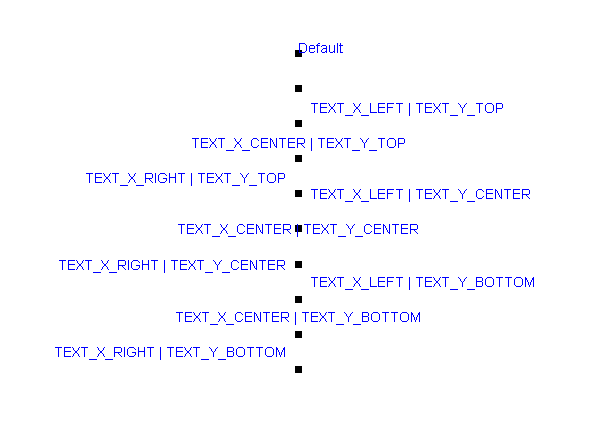


JMSL Chart Programmer's Guide
|
2D Drawing Elements >> Text Attributes |



|
Text Attributes
Attribute Font
Text is drawn using Font objects constructed using the FontName, FontSize and
FontStyle attributes. The ChartNode.setFont(Font) method does not save the
Font object, but sets these three attributes.
This arrangement allows one to specify font size and style at lower nodes and change the font face at the root node.
Multiline text strings are allowed. They are created by newline characters in the string that creates the text item.
Attribute FontName
FontName is a string-valued attribute that specifies the logical font name or a font face name. Its default value is "SansSerif". Java always defines the font names "Dialog", "DialogInput", "Monospaced", "Serif", "SansSerif", and "Symbol". Depending on the system, additional font names may be defined.
Attribute FontSize
FontSize is an integer-valued attribute that specifies the point size of the font. Its default value is 12.
Attribute FontStyle
FontStyle is an integer-valued attribute that specifies the font style. This can be a
bitwise combination of Font.PLAIN, Font.BOLD and/or Font.ITALIC. Its
default value is Font.PLAIN.
Samples
Following are sample fonts in styles plain, italic and bold. These may look different on different platforms.

Attribute TextAngle
TextAngle is an integer-valued attribute that specifies the angle, in degrees, at which text is drawn. The angle is measured counterclockwise. Its default value is 0.
Attribute TextColor
TextColor is a Color-valued attribute that specifies the color in which the text is
drawn. Its default value is Color.black.
Attribute TextFormat
TextFormat is a java.text.Format-valued or a String-valued attribute that
specifies how to format string objects.
TextFormat can also be set using a String, which is used to generate a Format object when the attribute is accessed. The Format object is created using the value of locale in the chart node.
Some strings have special meanings (case is ignored in these strings):
"Date(SHORT)" means use:DateFormat.getDateInstance(SHORT, locale)
"Date(MEDIUM)" means useDateFormat.getDateInstance(MEDIUM, locale)
"Date(LONG)" means use:DateFormat.getDateInstance(LONG, locale)
"Currency" means useNumberFormat.getCurrencyInstance(locale)
"Percent" means use:NumberFormat.getPercentInstance(locale)
If TextFormat has a string value that is not one of the above, then
new DecimalFormat(value, new DecimalFormatSymbols(locale))
is used. For example, if its value is "0.00", then numbers will be formatted with
exactly two digits after the decimal place. See DecimalFormat for a detailed
description of these format patterns.
The default value of TextFormat is the value returned by the factory method
NumberFormat.getInstance(locale).
Attribute Title
Title is a Text-valued attribute that contains the title for a node. The class Text holds a string and its alignment and offset information.
The alignment of a Text object is the bitwise combination of one of
The offset moves the start of the text away from the reference point in the direction of the alignment. So if the alignment bit TEXT_X_LEFT is set and the offset is greater than zero then the text starts a distance further to the left than if the offset were zero. The distance moved is the value of offset times the default marker size. The offset is usually zero, but the Data node sets it to 2.0 for labeling data points.
A Text object is drawn relative to a reference point. The alignment specifies the position of the reference point on the box that contains the text. There are nine such possible positions. In the following samples, the reference point is marked with a square

If the text is drawn at an angle, then the alignment is relative to the horizontally/ vertically aligned bounding box of the text.
| © Visual Numerics, Inc. All rights reserved. |



|